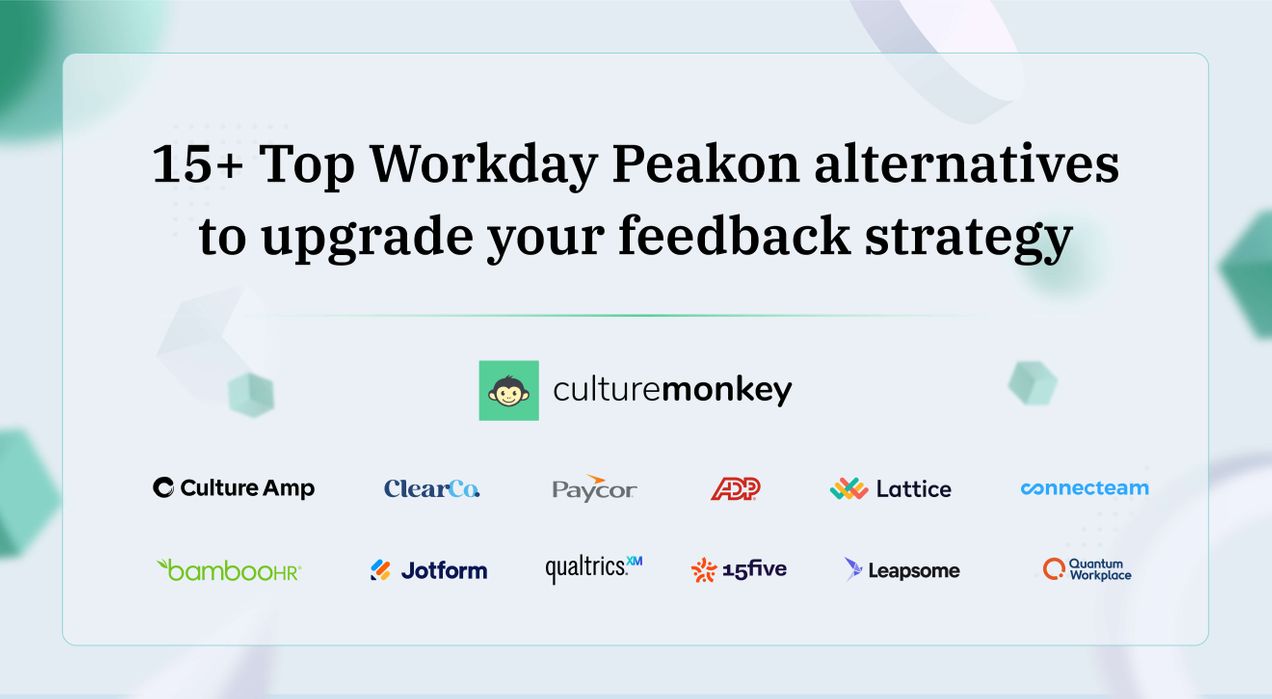Employee engagement survey results presentation: Tips, formats, and key metrics

If there’s one thing the Friends reunion taught us, it’s that people love a good reveal. But when it comes to unveiling employee engagement survey results, the stakes are much higher than a nostalgia trip. This isn’t just a "could’ve, would’ve, should’ve" moment, it’s a golden opportunity to drive real change in your organization.
You’ve done the hard part, getting employees to complete the survey. Now, the real challenge begins: making sense of the survey results, crafting an impactful employee engagement survey results presentation, and ensuring it leads to meaningful action. A well-structured survey results presentation isn’t just about numbers and graphs, it’s about turning survey data into actionable insights, boosting employee trust, and shaping an engagement strategy that sticks.
So, how do you present the employee survey results in a way that sparks conversations, fuels buy-in, and helps managers drive greater engagement? Let’s break it down The One Where HR Turns Data into Action, with smart formats, key metrics, and strategies that go beyond just ticking the “we did a survey” box.
TL;DR
Why presenting employee engagement survey results is important?

Presenting employee engagement survey results is important because it transforms raw survey data into meaningful insights that drive real organizational change. Without a clear survey results presentation, valuable employee feedback gets lost, leading to missed opportunities for improvement. A structured employee engagement presentation ensures transparency, builds employee trust, and helps management identify areas for action planning.
A well-executed employee survey results presentation is more than just a meeting, it’s a bridge between employee sentiment and leadership decisions. Employees feel heard when survey response patterns are acknowledged, and engagement scores are discussed openly. This fosters a culture of communication where different departments can collaborate on potential solutions.
Survey results guide the leadership team in shaping an employee engagement strategy that aligns with company culture. By sharing survey results effectively, organizations can encourage managers to take ownership of engagement improvements. This data-driven approach not only boosts employee satisfaction but also strengthens career development efforts, leading to long-term organizational success.
4 Key areas to address when sharing survey results
Sharing survey results is like mapping a road trip, if directions are clear, everyone knows the route and destination. Miss a turn, and confusion sets in. To ensure progress, organizations must communicate findings transparently, assign accountability, define next steps, and keep employees engaged through open dialogue and consistent follow-up actions.
- Clarity of findings: Present data in simple language so employees and executives easily understand engagement scores and trends.
- Manager accountability: Highlight team-level insights that managers can act on directly to improve morale and engagement.
- Actionable outcomes: Connect results to specific steps, ensuring feedback translates into real improvements rather than just discussion.
- Transparency with employees: Share both strengths and gaps openly to build trust and show commitment to meaningful change.
Key objectives of an employee engagement survey results presentation

A well-structured employee engagement survey results presentation is not just about showcasing numbers—it’s about driving meaningful change within an organization. The key objectives of presenting survey results go beyond simple reporting; they help leadership, managers, and employees align on the next steps for improvement. Here’s what a strong presentation should achieve:
- Communicate key findings effectively : A clear presentation of survey data allows different departments to understand engagement scores, employee sentiment, and areas requiring attention.
- Encourage managers to take ownership : Employee survey results provide actionable insights that managers can use to improve employee experience, job satisfaction, and work-life balance within their teams.
- Drive employee engagement strategy : Sharing survey results ensures leadership teams can identify areas for improvement and create a structured employee survey results action plan.
- Enhance employee trust and transparency : When employees feel their feedback is valued, participation in subsequent surveys increases, fostering a culture of open communication.
- Identify areas for targeted action planning : Using statistical data and sentiment analysis, organizations can develop focus groups and training programs tailored to specific needs.
- Provide relevant content for decision-making : From senior leadership to team leaders, everyone benefits from data analysis that informs engagement strategy, talent engagement strategies, and career growth opportunities.
- Ensure buy-in from the C-suite : Presenting survey results in a compelling format helps secure leadership support for initiatives that lead to greater engagement across the organization.
TL;DR
A strong employee engagement survey results presentation transforms raw data into clear insights that spark meaningful change. By turning survey findings into action points, organizations can ensure feedback directly shapes better practices and outcomes.
It also empowers managers with ownership, helps leadership align strategies, and builds trust through transparency. When shared effectively, results boost participation in future surveys and secure C-suite support for long-term engagement success.
7 Steps for effective employee engagement score communication
Sharing engagement scores is like unveiling a map after a long hike—people need clear directions to move forward. The key is showing employees what the numbers mean for them. When leaders translate data into everyday actions, workplace conversations turn into momentum for improvement
- Start with the why: Explain why the survey results presentation matters, showing how scores connect to employee experience and company goals.
- Highlight key themes: Focus on 3–4 major takeaways instead of overwhelming people with every detail.
- Tailor the message: Customize results for executives, managers, and employees so each group sees what’s most relevant.
- Balance positives and gaps: Celebrate strengths while openly addressing areas where improvements are needed.
- Use visuals wisely: Charts and graphs make data easier to understand and encourage quicker conversations.
- Link to next steps: Show employees how actions will be prioritized and what improvements are underway.
- Encourage feedback loops: Invite reactions and follow-ups to keep survey conversations alive beyond the first presentation.
How to prepare for an employee engagement survey results presentation?

Preparing for an employee engagement survey results presentation requires careful planning to ensure the survey data is clear, actionable, and effectively communicated to different departments. A well-structured presentation drives engagement improvement, encourages managers to take action, and ensures buy-in from senior leadership. Here’s how to get ready:
- Analyze the survey data thoroughly : Conduct detailed data analysis to identify key findings, trends in engagement scores, and areas for improvement. Look at employee demographics, statistical data, and survey response rates to gain deeper insights.
- Organize survey results into a compelling story : Simply listing numbers won’t create an impact. Structure the survey about the presentation to highlight employee sentiment, company culture, and focus areas for action planning.
- Create a visually engaging presentation : Use all the templates available to simplify complex survey results. Charts and graphs make it easier for managers and employees to understand engagement survey data.
- Identify areas that need immediate attention : Pinpoint root causes of low employee satisfaction, work-life balance concerns, or career development gaps. Develop an employee survey results action plan with potential solutions.
- Encourage managers to lead discussions : Team meetings should include open conversations about the survey questions, ensuring employee feedback translates into meaningful engagement strategy adjustments.
- Prepare key takeaways for leadership : Senior leadership and the leadership team need clear, actionable insights to drive long-term engagement. Their support will ensure subsequent surveys and future surveys receive higher participation.
Top metrics to highlight in your employee engagement survey results
A strong employee engagement survey results presentation should focus on the right metrics to provide meaningful insights. Highlighting key metrics ensures that senior leadership, managers, and employees can identify areas for improvement and develop an effective employee survey results action plan. Here are the essential metrics to include:
- Engagement scores : Measure overall employee engagement by analyzing survey response trends, identifying areas where employees feel highly engaged, and spotting gaps where engagement needs improvement.
- Employee satisfaction levels : Employee satisfaction is a critical indicator of workplace environment quality, company culture strength, and career development opportunities.
- Participation rates : Understanding survey participation helps organizations assess employee trust and identify areas where communication efforts need improvement to encourage greater engagement.
- Survey response distribution : Breaking down survey results by different departments, employee demographics, and individual employee experiences helps in data-driven decision-making.
- Work-life balance perceptions : Employees feel more engaged when their work-life balance is supported through relevant policies and flexible work arrangements.
- Key findings from open-ended employee feedback : Sentiment analysis of qualitative responses provides valuable insights into employee sentiment and factors influencing engagement.
- Effectiveness of previous action planning efforts : Comparing current survey results to past engagement survey data helps organizations assess whether action planning efforts have driven expected results.
- Training program effectiveness : Highlighting training program impact on employee engagement and job satisfaction ensures that learning initiatives remain aligned with organizational goals.
What survey metrics matter most when reporting to executives
Presenting employee survey results is like showing a dashboard during a flight, leaders don’t need every dial, just the ones that guide safe decisions. The right employee engagement survey results presentation focuses on metrics that move strategy, not just numbers.
- Overall engagement score: Executives want a single metric that reflects how employees feel about work, culture, and leadership.
- Participation rate: High response rates show employees trust the process, while low ones reveal gaps in communication or transparency.
- Manager effectiveness: Leaders track how well managers translate engagement into action, as this often shapes retention and performance.
- Turnover risk indicators: Executives value early warnings about attrition, especially when tied to engagement or satisfaction trends.
- Open-ended feedback themes: Qualitative insights highlight employee sentiment behind the numbers, helping leaders see the “why” behind engagement scores.
- Progress over time: Comparing current scores to past survey results shows whether actions are working or if strategies need adjustment.
Best practices for presenting employee engagement survey findings

Effectively presenting employee engagement survey findings ensures that survey data is understood, actionable insights are implemented, and employee trust is reinforced. A strong survey results presentation helps managers, senior leadership, and different departments make informed decisions that drive improvement. Follow these best practices:
- Start with key findings : Highlight the most critical survey results first, ensuring the leadership team and managers focus on areas that require immediate action planning.
- Use a clear and structured format : A well-organized employee engagement survey results presentation should categorize engagement scores, employee sentiment, and statistical data to enhance readability.
- Break down survey response trends : Show comparisons between different departments, employee demographics, and subsequent surveys to identify patterns and root causes of engagement gaps.
- Encourage managers to lead discussions : Engagement survey results should be discussed in team meetings, allowing employees to share perspectives and contribute to potential solutions.
- Turn insights into action : The presentation should outline an employee survey results action plan that includes targeted engagement strategy improvements, training programs, and company culture initiatives.
- Keep communication transparent : Sharing survey results openly with employees fosters buy-in and participation in future surveys while reinforcing employee feedback as a driver of change.
- Highlight positive feedback along with areas for improvement : Balancing constructive criticism with employee satisfaction highlights ensures employees feel valued and motivated.
TL;DR
An effective survey results presentation highlights key findings, compares trends, and balances positive feedback with areas for improvement. By fostering transparency and manager-led discussions, it drives meaningful action, builds trust, and motivates employees. This approach strengthens workplace culture, turning data into practical steps that support engagement, collaboration, and long-term organizational success.
Choosing the right format for your survey results presentation

Selecting the right format for your employee engagement survey results presentation ensures that survey data is effectively communicated to different departments, senior leadership, and managers.
A well-chosen format can enhance engagement, improve survey response interpretation, and make actionable insights more accessible. Here are the best formats to consider:
PowerPoint
A PowerPoint presentation is one of the most commonly used formats for sharing survey results. It allows for a structured, visual approach that simplifies data analysis and engagement scores.
- Helps the leadership team and managers focus on key findings without information overload.
- Allows the use of visuals like charts, graphs, and statistical data to enhance understanding.
- Works well for team meetings where survey results need to be discussed in real time.
- Ideal for summarizing an employee survey results action plan and ensuring buy-in from senior leadership.
Infographics
Infographics are a great way to share surveys about presentation results in a visually engaging and easy-to-digest format.
- Perfect for summarizing survey response trends across different departments.
- Encourages employees to engage with key findings quickly without lengthy reports.
- Ideal for highlighting employee sentiment, participation rates, and engagement scores.
- Can be shared in internal newsletters or company communication platforms to increase visibility.
Dashboards
Dashboards provide real-time access to employee engagement survey results and allow for continuous data analysis.
- Enables organizations to track employee survey results dynamically and identify areas needing improvement.
- Provides senior leadership and managers with a centralized hub for engagement strategy insights.
- Helps break down survey data by employee demographics, engagement survey trends, and sentiment analysis.
- Supports action planning by allowing teams to monitor survey response patterns over time.
Reports
Comprehensive reports are essential for deep-diving into employee survey results and providing a detailed breakdown of key takeaways.
- Useful for management teams that require thorough survey results analysis.
- Helps in identifying potential solutions through extensive data review.
- Includes employee feedback, statistical data, and comparisons with subsequent surveys.
- Supports structured action planning by offering a clear roadmap for engagement improvement.
How detailed should you get when sharing your employee survey results?
Sharing survey results is like giving directions on a busy highway, too vague, and people get lost; too detailed, and they miss the big picture. The goal is balance: enough clarity to build trust, but simple enough to inspire action. That’s where survey feedback reporting, UAE practices and the right employee engagement reporting tool make all the difference.
- Highlight big themes: Focus on 3–4 major findings instead of overwhelming employees with endless data.
- Break down by groups: Use an employee engagement reporting tool to show team-level trends without exposing individual responses.
- Balance positives with gaps: Share wins to build morale while openly pointing out areas for growth.
- Connect to action: Link results directly to clear next steps so feedback feels meaningful.
- Respect attention spans: Keep reporting concise with visual dashboards and short summaries that work well in survey feedback reporting UAE standards.
How to communicate survey results to different audiences?

Effectively communicating employee engagement survey results ensures that leadership teams, managers, and employees receive relevant content that helps drive meaningful change. Different audiences require different levels of detail and focus in the survey results presentation. Here’s how to tailor your communication strategy:
Leadership teams
The leadership team needs a high-level overview of engagement survey results to guide decision-making and action planning.
- Focus on key findings, engagement scores, and employee sentiment trends across different departments.
- Use dashboards, executive summaries, and data analysis to highlight survey response patterns and identify areas for strategic improvement.
- Provide comparisons with subsequent surveys to measure progress and track expected results.
- Ensure buy-in by connecting survey data to business goals, company culture, and talent engagement strategies.
Managers
Managers play a crucial role in implementing engagement strategy improvements based on survey results. They need practical, actionable insights to drive engagement within their teams.
- Share department-specific employee survey results, breaking down engagement survey data by employee demographics.
- Conduct team meetings to discuss engagement scores, training program needs, and potential solutions for improvement.
- Encourage managers to take ownership of survey response trends and implement relevant action-planning steps.
- Provide all the templates needed for structured communication and follow-up discussions.
Employees
Employees feel valued when survey results are communicated transparently and in a way that highlights their role in shaping company culture.
- Share survey results through infographics, internal newsletters, or all-hands meetings to improve participation in future surveys.
- Emphasize positive feedback while addressing key areas for improvement, such as work-life balance and career growth opportunities.
- Use sentiment analysis and survey questions breakdowns to help employees understand how their feedback influences action planning.
- Encourage open discussions in team meetings, ensuring employees feel heard and engaged in engagement survey strategy adjustments.
Common challenges in presenting employee engagement survey results and how to overcome them
Presenting employee engagement survey results can be complex, especially when trying to ensure clarity, transparency, and engagement improvement. Organizations often face challenges in making survey data meaningful and actionable. Here’s how to address these common obstacles:
Lack of clarity in survey results
- Engagement scores, employee sentiment, and survey response patterns can become overwhelming without proper data analysis.
- Solution: Use infographics, dashboards, and clear visuals in the survey results presentation to simplify statistical data and highlight key findings.
Low engagement from leadership teams
- If senior leadership doesn’t see the relevance of engagement survey results, buy-in for action planning may suffer.
- Solution: Present survey results in a way that aligns with business goals, company culture, and potential solutions for improvement.
Managers unsure how to act on survey response trends
- Without clear direction, managers may struggle to translate employee survey results into meaningful engagement strategy improvements.
- Solution: Provide all the templates needed for structured action planning and encourage managers to hold discussions in team meetings.
Employees feel disconnected from survey results
- Employees feel disengaged when they don’t see how their feedback leads to real change.
- Solution: Share survey results openly, discuss findings in different departments, and highlight work-life balance and career development improvements.
Difficulty in tracking progress over time
- Organizations may find it hard to measure improvement from subsequent surveys.
- Solution: Compare current employee engagement survey results with previous engagement survey data and use dashboards to track progress in future surveys.
Why transparency is becoming a priority for UAE HR leaders?
Transparency in HR is like sunlight in a workplace, when it shines through, people feel safe, valued, and aligned. In the UAE, leaders are realizing that employee feedback transparency UAE is no longer optional but essential. A thoughtful internal feedback communication strategy helps turn survey insights into trust-building actions employees believe in.
- Trust over control: Sharing results openly reassures employees that feedback won’t be hidden or ignored.
- Boosting engagement: Transparent communication encourages staff to take surveys seriously and participate actively.
- Clear action planning: An internal feedback communication strategy helps link survey findings to visible improvements.
- Stronger employer brand: Companies that practice openness attract and retain top talent in competitive UAE markets.
- Sustaining momentum: Regular updates on progress show transparency is ongoing, not a one-time gesture.
The role of storytelling in employee engagement survey presentations
Storytelling transforms an employee engagement survey results presentation from a dull data report into a compelling narrative that inspires action. Instead of just sharing numbers, a well-crafted story connects survey results to real employee experiences, making engagement scores and survey response trends more meaningful. Here’s why storytelling is essential:
Makes survey data relatable
- Numbers alone can feel impersonal, but adding context through storytelling helps different departments and managers understand the human impact behind the survey results.
- Framing engagement survey results as part of an ongoing journey reinforces company culture and highlights areas for improvement.
Creates emotional engagement
- Employees feel more connected when survey results are presented as part of a broader story about workplace environment, employee satisfaction, and career development.
- Stories of success from past action planning efforts can boost employee trust and encourage greater engagement in future surveys.
Drives action and accountability
- A compelling narrative helps leadership teams and managers see how survey data translates into real-world challenges and potential solutions.
- Storytelling can highlight key findings and show how targeted engagement strategies can lead to measurable improvement in work-life balance and job satisfaction.
Encourages open communication
- Presenting survey results with real-life examples helps employees feel heard and valued.
- Sharing insights through storytelling fosters a culture of transparency, making it easier to drive buy-in for subsequent surveys and ongoing engagement strategy initiatives.
Turning survey insights into action plans
A successful employee engagement survey results presentation isn’t just about sharing survey data—it’s about using those insights to drive meaningful change. To ensure engagement improvement, organizations must develop a structured employee survey results action plan that turns findings into tangible outcomes. Here’s how:
- Identify areas that need action: Review engagement scores, survey response trends, and employee sentiment to pinpoint key findings. Break down survey results by different departments to understand where targeted engagement strategies are needed.
- Prioritize key focus areas: Use statistical data and sentiment analysis to determine which issues impact employee satisfaction, work-life balance, and career development. Involve the leadership team in prioritizing action planning efforts that align with company culture and business goals.
- Encourage managers to take ownership: Action planning should involve managers at all levels, ensuring they discuss survey results in team meetings and develop department-specific engagement strategies. Provide all the templates needed for structured follow-ups to track progress and measure expected results.
- Implement training programs and communication strategies: Address engagement survey concerns by investing in training programs that enhance leadership skills, communication, and workplace environment improvements. Keep employees informed about progress to maintain engagement and participation in future surveys.
- Track and measure improvement: Compare current employee engagement survey results with subsequent surveys to evaluate progress. Use dashboards to monitor survey response trends and ensure engagement strategy efforts are delivering measurable results.
The role of leadership trust in sharing feedback in Middle Eastern workplaces
Trust in leadership is like the foundation of a building, without it, even the strongest walls collapse. In Middle Eastern workplaces, leaders who communicate employee insights openly foster belonging, alignment, and resilience. Building credibility in employee engagement data communication sets the tone for how feedback drives real change.
- Lead with transparency: Leaders who openly share survey results build confidence and show employees that their voices matter.
- Respect cultural context: Tailor employee insights communication to reflect local values, balancing openness with sensitivity.
- Model accountability: When leaders act on feedback, it strengthens trust and encourages employees to engage with future surveys.
- Simplify the message: Clear employee engagement data communication prevents misinterpretation and helps teams focus on solutions.
- Close the loop: Regular updates on progress show employees that feedback isn’t forgotten but actively shaping workplace culture.
How to measure the effectiveness of your survey results presentation?
The effectiveness of your survey results presentation can be measured by:
- Survey response trends: A strong presentation should lead to improved participation in subsequent surveys, showing that employees feel their feedback is valued.
- Engagement scores: Tracking changes in engagement scores over time helps determine whether survey results have driven meaningful action.
- Leadership team buy-in: If senior leadership supports and implements engagement strategy initiatives, it indicates that the presentation successfully highlighted key findings.
- Manager engagement: Monitoring whether managers discuss survey results in team meetings and take ownership of action planning ensures the insights are being translated into improvements.
- Employee feedback: Gathering feedback on how clearly survey results were communicated helps refine future surveys and presentations.
- Tracking progress through dashboards: Comparing engagement survey data with past survey results using dashboards and statistical data ensures expected results are being met.
Significance of post-meeting survey questions in understanding the presentation

Post-meeting survey questions play a crucial role in evaluating the effectiveness of an employee engagement survey results presentation. They provide actionable insights into how well the information was understood, whether the key findings resonated, and what improvements can be made for future surveys.
- Assess clarity and comprehension: Post-meeting survey questions help gauge if employees, managers, and the leadership team fully grasped the engagement survey data, engagement scores, and employee survey results action plan.
- Measure engagement and participation: Understanding how actively employees engaged with the presentation, whether they found the content relevant, and if they felt encouraged to participate in subsequent surveys is essential.
- Identify areas of confusion: Responses can highlight gaps in communication, such as unclear survey response trends, statistical data misinterpretations, or lack of actionable insights for different departments.
- Gather feedback for improvement: Questions focused on content structure, engagement strategy discussions, and action planning clarity help refine future presentations.
- Strengthen engagement strategy: Platforms such as CultureMonkey enable organizations to collect real-time feedback on survey results presentations, helping to improve communication strategies, work-life balance discussions, and training program alignment.
How CultureMonkey simplifies survey result sharing at scale
Sharing survey findings is like conducting an orchestra, if each section plays on its own, the music feels scattered. A strong presentation on survey results unites every voice into one clear score that leaders can act on.
CultureMonkey streamlines this process with people science-driven insights and intuitive dashboards, making results easy to access, interpret, and act on.
- People science-backed reports: Get actionable insights that go beyond numbers, powered by proven people science frameworks.
- Manager Dashboard: Equip managers with tailored dashboards to interpret their team’s results and drive local action.
- Multiple formats to share survey results: Export and distribute results in presentations, spreadsheets, or dashboards depending on stakeholder needs.
- Action-planning with collaborative Kanban board: Move from insights to execution with an interactive board that enables cross-functional collaboration.
- Role-based access: Securely manage visibility with super admin, sub-admin, and manager-level dashboards.
Conclusion
In the journey of understanding and enhancing employee engagement, effectively presenting survey results is paramount. It's not merely about showcasing data but weaving a narrative that resonates with every stakeholder, from the leadership team to individual employees. By interpreting survey insights thoughtfully and crafting compelling presentations, organizations can foster a culture of transparency and continuous improvement.
At CultureMonkey, we recognize the power of meaningful storytelling in driving engagement. Our platform is designed to help you transform raw survey data into actionable strategies, ensuring that every voice within your organization is heard and valued. Embrace the opportunity to elevate your employee engagement initiatives and witness the positive ripple effects across your company.
Summary
FAQs
1. What is the best way to present employee engagement survey results to leadership?
The best way to present employee engagement survey results to leadership is by focusing on key findings, engagement scores, and statistical data. Use dashboards, infographics, and structured reports to provide clear insights. Emphasize action planning, root cause analysis, and potential solutions to ensure senior leadership aligns engagement strategies with company goals and expected results.
2. How can I ensure employees trust the survey results?
To build employee trust, organizations should practice transparent communication, openly sharing survey results with employees. Discuss survey response trends in team meetings, highlight engagement improvement plans, and encourage managers to address concerns. Comparing engagement survey data with subsequent surveys and implementing action planning based on employee feedback strengthens trust and increases participation in future surveys.
3. What tools can I use to present employee survey findings effectively?
Tools such as PowerPoint, dashboards, and infographics simplify survey results presentations effectively. Platforms such as CultureMonkey help you visualize survey data, track survey response trends, and generate all the templates needed for engagement strategy discussions. Interactive reports with sentiment analysis and statistical data help different departments understand the impact of engagement survey results.
4. How do I address negative survey results in a presentation?
Address negative employee engagement survey results by focusing on data analysis and action planning. Avoid defensive responses; instead, highlight key areas for improvement, employee feedback insights, and engagement strategy updates. Encourage managers to discuss survey response trends openly, linking concerns to concrete engagement improvement initiatives, such as training programs or workplace environment enhancements.
5. What’s the ideal length for an employee survey results presentation?
An ideal employee engagement survey results presentation should be concise yet comprehensive, lasting anywhere between thirty to forty-five minutes. This allows enough time for data analysis, discussion of key findings, and action planning. Managers should also hold follow-up team meetings to dive deeper into the survey response insights, engagement strategy adjustments, and future survey planning.
6. What to do with employee engagement survey results?
Begin by interpreting employee engagement survey results to spot key patterns. Next, build an employee survey results action plan and share survey results with real time PowerPoint updates. Leverage an employee engagement survey results and action plan ppt to help managers convert feedback into practical improvements, fostering accountability, collaboration, and measurable engagement gains across teams.
7. What are the three key elements of employee engagement?
The three key elements of employee engagement are clarity, recognition, and growth. An employee engagement survey report emphasizes these factors, guiding leaders to design initiatives that enhance trust, morale, and productivity. With an employee engagement survey analysis ppt, organizations can easily visualize, communicate, and act on these drivers, ensuring employees feel valued while aligning engagement strategies with business success.
8. Why is presenting employee engagement survey results important?
Presenting employee survey results builds transparency by showing staff their feedback drives real change. An employee engagement survey results presentation template or employee satisfaction survey results presentation makes insights clear, helping leaders strengthen trust, guide action planning, and align improvements with organizational goals while reinforcing accountability and commitment to continuous employee engagement progress.
9. What’s the best format to communicate survey findings?
The best format for presenting employee engagement survey results depends on the audience. Executives prefer dashboards for quick insights, managers rely on employee engagement survey results and action plan PPT slides for clarity, and employees engage better with infographics. Sharing employee engagement survey results templates ensures consistency, transparency, and alignment, keeping engagement strategies effective across all organizational levels.
10. How do you ensure anonymity when sharing results?
Anonymity in sharing employee engagement survey results is ensured by aggregating responses, removing team-level identifiers, and using employee satisfaction survey results communication tools. When presenting survey results with real time PowerPoint summaries, employee identities remain protected while still providing leaders with actionable insights that highlight key engagement trends, build trust, and guide meaningful organizational improvements.
11. Can CultureMonkey segment and automate result sharing by department?
To ensure anonymity when sharing employee engagement survey results, aggregate responses and avoid team-level identifiers. Use employee satisfaction survey results communication tools that safeguard identities. When presenting real time PowerPoint summaries, highlight actionable engagement insights without exposing individuals, maintaining trust while still providing leadership with the clarity needed to guide improvements and align strategies effectively.



